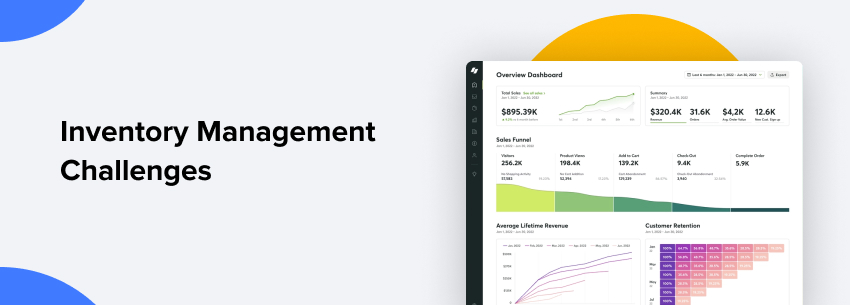Businesses across different industries have transformed drastically over the past couple of years. With the covid acting as a catalyst to the transition, the world has witnessed extensive digitization, further fuelling the growth of online businesses.
As a result, the demand for eCommerce website development companies is increasing rapidly. eCommerce businesses have emerged as a highly profitable avenue for generating revenue while providing enhanced convenience to end customers. However, this thriving sector is not without its share of challenges that can impact the overall profitability of a business.

Hence, it is crucial to promptly identify and tackle these eCommerce challenges by implementing effective strategies. By doing so, businesses can ensure sustainable growth and success in the competitive online marketplace.
eCommerce = Future Business Opportunity
Another factor that makes this important is the role eCommerce businesses play in today’s day and age. This development in the international market has opened the windows for many businesses regardless of their scale or nature. So companies looking to capitalize on this opportunity must be aware of the challenges.
These eCommerce challenges are more complex and nuanced than many might imagine. These complications include technical, shipping, fulfillment, inventory management, and marketing challenges.

These challenges further contribute to hidden costs associated with running an eCommerce business.
So let’s look at these challenges and determine ways to mitigate their adverse implications in this detailed blog. Continue reading as we understand these challenges and explore the possible solutions in the following sections.
Cost No.1: Technical Issues

Technical issues are part and parcel of every business. However, things get different when discussing technical issues associated with eCommerce businesses. These issues are as wide-ranging and nuanced as they can get. Regardless of the type or nature, these complications can increase hidden costs in running a successful eCommerce business.
Cart Abandonment: The No 1 Issue With eCommerce Entrepreneurs
Cart abandonment is one of the most common technical issues that eCommerce businesses face today.
Nowadays, it is common for eCommerce customers to add products to their cart but not complete the purchase. This phenomenon contributes to direct loss of sales and further damage to the business’s reputation. Therefore, it’s no surprise that cart abandonment is one of the most critical issues in the eCommerce industry.
There are many reasons why cart abandonment has become such a significant concern in the eCommerce industry. But unfortunately, these reasons can vary based on different scenarios making it even more challenging to determine and overcome these challenges.
Yet many eCommerce businesses need to try to reach out to those customers using other channels. While this helps in some instances, eCommerce businesses still need to incur an added cost to get any results.
Sales Returns: The Loss Multiplier

Another significant issue on this front comes from sales returns that eCommerce businesses have to deal with. Of course, it is worth noting that every eCommerce business has to deal with sales returns no matter how great their offerings are. Therefore, it is essential to ensure they take all necessary measures to reduce returns and drive better profitability.
Even today, sales returns have increased drastically, with return rates going as high as 40% in the post-pandemic period. However, another significant concern is the risk of fraudulent returns or wardrobing. In these cases, customers wear or use a product and return it afterward. In these cases, hidden costs of eCommerce can skyrocket further, resulting in lower overall profitability.
One of the best ways to deal with such challenges is to make it easier for people to make returns. Paradoxical as it may sound, the notion of having a smooth returns process instills greater confidence among customers.
As a result, they are automatically less likely to go with the return and use the product or service without hesitation. Besides that, enhancing existing product descriptions, better sizing, and image quality can also help bring down eCommerce returns.
Cost No.2: Shipping and Fulfillment Challenges

One of the best things that fueled the popularity of eCommerce businesses was convenient shipping and better fulfillment. This means that people can now shop for various products and services from their homes.
Yet, one of the primary challenges that eCommerce businesses have to deal with today are challenges related to shipping and fulfillment. So it is fair to conclude that shipping and fulfillment is one of today’s market’s most unexpected eCommerce challenges.
Issues With International Shipping
For starters, there is the issue with international shipping which can take much longer, from weeks to even months, in some instances. Even international eCommerce customers are well aware of this phenomenon, but not every product or service you sell is worth all that wait.
This is where offering different types of shipping options can be very helpful. You can ask customers to pay more for premium delivery services to get their products sooner. But if your customers are unwilling to pay such premium prices, this will become a hidden eCommerce cost.
This is where the shipping cost factor comes into the picture to transform this ordeal entirely. It is not surprising that shipping costs can vary based on the location of your eCommerce, but you still need to ensure it is reasonable. Therefore, determining the right shipping cost would mean striking the right balance between profitability and the customer’s willingness to pay.
International Shipping = Added Expenses

Failing to strike this balance would mean added costs for your business in terms of more shipping expenses. On the other hand, there is the concern of lower customer satisfaction mainly due to higher shipping charges on the customer’s end.
As a result, this creates a unique lose-lose situation for eCommerce businesses, who often struggle to determine the shipping cost. Besides that, this entire phenomenon can also contribute to further damaging customer satisfaction and profitability loss.
Cost No.3: Inventory Management Challenges

Success does not come easy in the case of eCommerce business. Multiple factors must work together to help an eCommerce business operate successfully. Inventory management is one of those important factors that every eCommerce business owner needs to be mindful of.
In simple terms, eCommerce inventory management is a unique yet important system that deals with inventory management. This means the location where you store your products and other relevant factors. These things can have a very drastic impact on the overall stature and success of the business.
Effective inventory management ensures that businesses have the right stuff at the right time, place, and condition. Failing to maintain your inventory appropriately can cost your business drastically.
Now that you understand inventory, you might already understand its significance for your business’ success. But even so, it is worth clarifying that inventory management, directly and indirectly, impacts almost every aspect of your business.
Better Inventory Management = Better Operations
Inventory management will help you get better inventory count and location visibility. As a result, you get a better sense of the product’s status, which can be anything from overstocked, out of stock, understocked, or even missing entirely. This visibility will further help you predict future purchasing requirements and prepare for potential shortages from the start.
Inventory management has always been a challenging aspect of every business, no matter its scale or nature. Therefore, it does not surprise that eCommerce businesses are no exception on this front. As a result, multiple common challenges are associated with eCommerce inventory management.
Inaccurate inventory counts are one of the biggest eCommerce inventory management challenges that businesses face in today’s day and age. Considering that efficiency is imperative, having the right understanding of your inventory is no longer an option.
Every eCommerce business must have a real-time update of its inventory counts. It is recommended that eCommerce businesses now use inventory tracking solutions to realize this goal with little complication. Failing on this front would mean more inventory tracking costs, contributing to a hidden cost.
Growth = A Contributing Factor For eCommerce Business Owners
Growth is the ultimate goal of eCommerce business, and this is where scalability becomes a very important aspect. No business can scale its operations without a thorough idea of its inventory. Unfortunately, relying on conventional manual processes can cost your business dearly.
The more business grows your inventory must grow in tandem, but you might not always be able to reap the benefits of this growth. Hence minimizing your reliance on manual labor is the right way to move forward.
Automating your inventory management processes will make it much easier for your business to reach its true potential. But more importantly, this will help your business mitigate unprecedented losses or costs.
Access to the right information at the right time is another significant challenge troubling eCommerce businesses. This becomes even more imperative in the case of effective inventory management, where analytics can play a significant role. Even in today’s digitized business environment, most businesses lack access to the right information at the right time.
As a result, they spend more on accessing the right information at the right time. But thankfully, this doesn’t have to be a concern any longer, all thanks to the potential of digital solutions. Businesses can now use these solutions to access accurate information about their inventory and carry out business accordingly to save on unwanted costs.
Magento Development: The Ultimate eCommerce Solution
These solutions can help eCommerce businesses access the right information at the right time to ensure more effective and efficient delivery. Besides that, businesses using inventory management solutions automatically gain a competitive advantage over others offering similar solutions.
The best part of it all is that inventory management does not have too much of a challenge with access to the right experts offering custom Magento development services. As a business, you can leverage its offerings to create the ideal inventory management solution based on the specific requirements of your business.
This way, you can realize your business goals much more quickly and facilitate better growth with a competitive edge over others. Apart from using digital solutions to facilitate better inventory management, you can also focus your efforts on optimizing your inventory management processes.
This is an integral enhancement for every eCommerce business striving to facilitate better inventory management to realize their goals with much ease. You must strive to re-evaluate all your inventory management processes and determine flaws within those processes. Once you have determined those goals, you can easily make changes and streamline processes further to drive better results and build a robust reputation for your business in the market.
Cost No.4: Marketing and Advertising Challenges

With a better idea of multiple challenges that can hamper the growth and scalability potential of eCommerce businesses, it is time to focus on marketing and advertising. There is no denying that marketing and advertising are among the most challenging aspects for every business.
However, this becomes even more of a concern for eCommerce businesses since they deal with an entirely different marketing and advertising sphere. With digital marketing’s popularity rising, multiple novel challenges have recently surfaced.
Digital Marketing = The Basics Of eCommerce
The first step in dealing with these challenges is identifying them and taking appropriate measures to mitigate their impact on the overall functioning of the business. Even though digital marketing is challenging, that does not mean it’s impossible. Instead of worrying about these challenges alone, it is important to determine the right measures to tackle them with efficacy.
Anyone familiar with digital marketing is well aware of the important role content marketing plays in the entire. Therefore, using the right content to market your business and its offerings with efficacy makes sense. Besides that, you must also remember that content marketing also plays an imperative role in enhancing the SEO performance of your website.
This is imperative since simply having a website without being able to reach anyone yields a tangible value for your eCommerce business. But even with a little effort into content marketing, your eCommerce business can reach the right customers and even drive better conversion rates to drive better growth.
A Balance Between Digital And Conventional Marketing
Besides online marketing and advertising, there is also the hassle of conventional marketing even today. Of course, the online market is significant today, but that does not relieve you from traditional marketing tactics altogether. Instead, you must take a cumulative approach by combining essential online and traditional marketing tactics elements.
For starters, you will need to spend significant money on banners, posters, and other relevant things to build a reputation for your business. You can do that online, but a real banner depicting your offerings also has a profound impact on the overall buying decision of customers.
Besides, spending money on announcing your offerings can also go a long way in realizing your business goals. So ensure you are prepared for these expenses beforehand to ensure this does not take you by shock when the time comes.
There are multiple ways you can deal with these marketing and advertising challenges. For instance, you can use social media platforms to target the right customers and boost conversion rates. Besides that, you can also enhance the overall design and navigability of your eCommerce business’ website to generate more traffic to the website.
Conclusion
There is no denying that running an eCommerce business successfully is one of the most challenging tasks in today’s competitive business environment. However, realizing those goals will become much easier if business managers take the right steps with the right skills and tools. This means no matter how adverse or unexpected eCommerce challenges are; there is always important to take the right measures to mitigate the overall impact of these challenges.
Therefore, make sure you are well aware of these challenges and start working on mitigating the impact of these challenges on the overall functioning of the business. You can even leverage the expertise of a reliable eCommerce partner to help your business mitigate all challenges. These partners have the right skills and expertise to help your business reach its true potential.
FAQs
Many unexpected eCommerce challenges can lead to unanticipated hidden costs. Some of the best-known of these eCommerce challenges include advertising and marketing challenges, technical challenges, shipping and fulfillment challenges, and lastly, inventory management challenges.
Unexpected eCommerce challenges are something that businesses are not something that businesses are prepared for. Therefore, when something such happens in reality, businesses have to pay for them to mitigate their impact. This is how unexpected eCommerce challenges can lead to hidden costs.
Businesses can do so many things to prepare for unexpected eCommerce challenges. However, the best way to deal with those challenges is to determine them beforehand and work on measures to mitigate their impact. Therefore, businesses must muster all their resources to identify challenges and prepare themselves accordingly.
Website downtime can severely impact the overall operability of an eCommerce business. This does not surprise you since your website is the only way customers can reach your business. So if your website is down, it is inevitable that you will miss out on a great deal of business opportunities.
Cybersecurity breach generally refers to third parties gaining unauthorized access to a business website. Many things can go wrong in these instances, such as your business has to deal with an adverse impact on reputation, lower credibility, and much more.
Unexpected returns are when customers might return your products without proper reason. These returns can dramatically impact the overall profitability of your eCommerce business. You will have to pay for the shipping of the said return while losing valuable time and resources on the customer without any profit.
Chargebacks are customer protection mechanisms where banks request a certain amount of charge from the merchant. If you sell a product or service as an eCommerce business, the customers pay you with a third-party bank card or online mode. These charges can impact eCommerce, but merchants can always find ways to recover these costs from customers either directly or indirectly.
Related Articles
-
V-commerce – The Next Big Thing After Ecommerce and Mcommerce
Talking About V-commerce – The Next Big Thing After Ecommerce and Mcommerce, Online shopping has been acclaimed by people across the world since quite a lot of time now. It
-
How AI Is Transforming The Online Shopping Experience
AI-driven customer service refers to applying artificial intelligence technologies to automate and improve the customer support experience in ecommerce. Providing outstanding customer service is critical for business success in today’s
-
How to Create a Successful Online Store as an Entrepreneur in 2023
The retail industry is undergoing a significant transformation. With the rise of e-commerce and online shopping, traditional brick-and-mortar stores struggle to compete. However, it is not all doom and gloom




